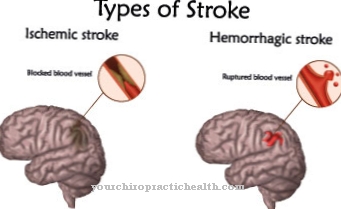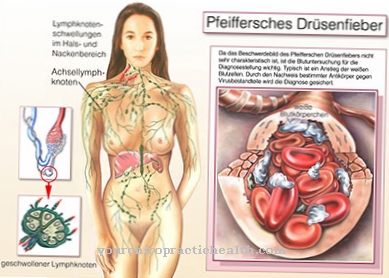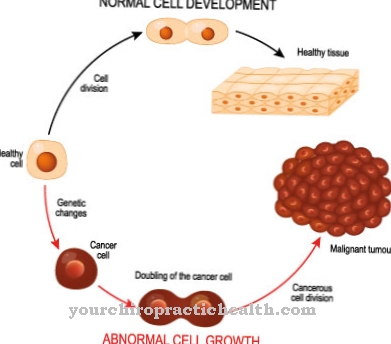Favism occurs because of a defect in the G6PD gene, which codes for an important enzyme in the human body. The enzyme deficiency leads to anemia and hemolysis and cannot be treated causally. The prognosis is very good if those affected avoid triggering substances for life.
What is favism?

© TheVisualsYouNeed - stock.adobe.com
Favism is the pathological course of an enzyme deficiency. Affected people have a mutation in the G6PD gene, which leads to a lack of glucose-6-phosphate dehydrogenase in the body. The consequences are anemia, a too low concentration of hemoglobin in the blood as well as recurring hemolysis in which the erythrocytes are destroyed.
Overall, a little less than 8 percent of all people have mutations in the G6PD gene; however, only 25 percent of them develop favism. People with this gene mutation who have already developed symptoms should avoid any contact with substances that are dangerous to them. These include, for example, Vicia faba beans and their pollen.
Favism occurs predominantly in the Mediterranean area, parts of Africa, the Middle East and some Asian countries such as Thailand or India. Amazingly, there is no malaria outbreak in those affected by favism, as the malaria pathogens can hardly multiply due to the lack of enzymes.
causes
Favism is a hereditary disease that is inherited as an X-linked recessive trait. Since inheritance is X-linked, women are affected significantly less often than men. Women can compensate for a genetic defect on one X chromosome with the other. Men only have one X chromosome, which is why a mutation on a gene there cannot be compensated for. The mutation in the G6PD gene is particularly prevalent among ethnic groups that live in the area where the malaria pathogen is distributed.
Glucose-6-phosphate dehydrogenase plays an important role in the human metabolism. A deficiency means that reactive chemical compounds, namely peroxides, can attack components of the red blood cells unhindered. This causes chronic anemia and hemolysis to occur. Basically, the symptoms only set in when those affected come into contact with the triggering substances. These substances are found in broad beans (Vicia faba), currants and peas, among others.
The disease can also be triggered by various other substances such as acetylsalicylic acid or antimalarial drugs. Stress and infection can also trigger favism.
Symptoms, ailments & signs
Symptoms and complaints typically only appear some time after contact with the triggering substances. The first signs can usually be seen after a few hours. However, it can also take a few days for symptoms to appear. Not everyone with a G6PD gene defect will automatically develop favism. Why the disease breaks out in some people with the mutation and not in others is not yet fully understood.
Favism is not infrequently associated with serious and potentially life-threatening symptoms. The first signs of a relapse are stomach and back pain, fever, chills, and a general feeling of weakness. With severe hemolytic anemia, patients are usually in a life-threatening state of shock. If the course is severe, a flare-up can lead to acute kidney failure.
diagnosis
As part of the diagnosis, a detailed anamnesis is first taken. The attending physician asks about the intake of medication and about contact with triggering foods such as field beans. In order to make a final diagnosis, the doctor takes blood, which is examined in a laboratory. In the case of a G6PDH deficiency, reduced enzyme activity is found.
So that the test results cannot be falsified, the enzyme activity in the reticulocytes, the precursors of the red blood cells, is examined. It also makes sense to have the number of reticulocytes determined. The course of the disease is mild in most cases, as long as triggering substances are avoided. However, if those affected do not know anything about their disease, a severe enzyme deficiency can occur, which significantly reduces life expectancy.
Complications
As a rule, there are no complications with favism if the patient completely avoids contact with the respective substance or substances. This can restrict everyday life and life, which reduces the quality of life. In many cases, favism is difficult to identify because symptoms do not appear until several days after exposure to the triggering substance.
If you do without this substance, favism can be avoided. Those affected mainly suffer from severe pain in the abdomen, abdomen and back. There is also a fever and chills, which is why the symptoms of favism are often mistaken for a cold or flu. In addition, there is a feeling of weakness, dizziness and often vomiting.
However, the patient also goes into shock, which can differentiate the favism from the flu. If not treated directly, the favism can damage the kidney. In many cases, treatment is not possible. The patient has to avoid certain ingredients throughout their life. This does not reduce life expectancy.
Severe attacks are treated in the intensive care unit and do not lead to any further complaints if treated quickly and early. Due to the lack of hygiene and medical care in the countries in which favism tends to occur, this can lead to serious complications.
When should you go to the doctor?
A favism cannot be treated directly and causally. Those affected are therefore not always dependent on a doctor. Above all, by avoiding the triggering substances, the symptoms can be completely avoided. A doctor should be consulted if the symptoms result in an acute emergency. This is e.g. this is the case when the person has a high fever and severe pain in the abdomen or back.
A general feeling of weakness and tiredness can also indicate the disease and should definitely be examined. The disease can also lead to shock. If the patient loses consciousness due to the symptoms, an emergency doctor must be called directly or the hospital selected. Most often, the disease can be diagnosed by a general practitioner or directly in the hospital. Since there is no causal treatment for the disease, patients must avoid the causative agent for their entire life. In most cases, the patient's life expectancy is not negatively affected by the disease.
Doctors & therapists in your area
Treatment & Therapy
To date, there is no treatment for favism that eliminates the underlying cause. The gene mutation exists from the moment of fertilization and cannot be treated. People affected by favism must avoid any contact with the substances that cause the disease for their entire life. This applies to foods like beans and peas as well as to certain drugs. If this succeeds, life expectancy is not reduced compared to the unaffected population.
Favism is particularly problematic if the disease remains undetected for a long time and then there is contact with a triggering substance. This leads to a severe episode, which must be treated in intensive care. Because of the severe hemolytic anemia that can accompany favism, there is a risk of serious complications.
In individual cases, haptoglobin is used for therapy. This is a protein found in the blood plasma that is involved in the transport of hemoglobin. With hemolysis, the haptoglobin level in the blood is low. This treatment is not suitable for all patients and is only used in emergencies.
Outlook & forecast
Since favism is a genetic disease, it is currently considered incurable. With the current medical and especially the legal requirements, no changes to human genetics can be made. However, not all carriers of the gene mutation experience an outbreak of the symptoms of enzyme deficiency.
Patients who show symptoms have a good prognosis under certain conditions. With compliance with medical requirements, there is the prospect of lifelong freedom from symptoms. The health impairments of the enzyme deficiency are triggered in the affected patients as soon as they ingest selected substances through their food intake.
A permanent renunciation of the triggering nutrients leads to recovery. If the substance concerned is consumed in the further course of life, symptoms arise immediately. Nevertheless, spontaneous healing occurs as soon as the substances are removed from the organism. In exceptional cases, irreversible damage to the organism occurs when the substances are absorbed.
In an acute condition due to the enzyme deficiency, acute kidney failure can result in failure of the kidneys to function. In these cases, the patient needs a donor kidney transplant so that there is a prospect of recovery. Otherwise, lifelong medical dialysis treatment is necessary or the patient dies prematurely.
prevention
The genetic defect that is the cause of favism cannot be prevented because it already exists before birth. To prevent flare-ups, those affected must be careful not to come into contact with triggering substances such as field beans. When treating bacterial or viral infections, the doctor must be informed about the enzyme deficiency because some drugs contain substances that are dangerous for those affected. For example, drugs with sulfonamides or acetylsaliclyic acid should not be taken.
Aftercare
In the case of favism, in most cases there are no or only a few measures and options for follow-up care available to those affected. The person affected is primarily dependent on the early detection and subsequent treatment of the disease in order to prevent further complications. Only through early detection of the favism can further complaints be prevented.
Independent healing cannot occur. Since favism is a genetic disease, it can also be passed on. If you want to have children, genetic counseling should therefore also be carried out in order to avoid this. The person affected should avoid contact with the triggering substances in any case.
A doctor should clarify which substances are involved. Furthermore, those affected are very often dependent on the help of acquaintances and friends or even family in their everyday life to make this easier.Conversations are also useful in order to prevent psychological upsets or depression that could result from favism. It cannot be universally predicted whether the disease will lead to a reduced life expectancy. Contact with other affected persons can also be useful with this disease.
You can do that yourself
Self-help measures are not enough in the event of an acute hemolytic crisis. She needs immediate medical treatment. The underlying enzyme defect is incurable. However, those affected can prevent its consequences - anemia and acute attacks - by avoiding the triggering substances and products.
These include beans, especially the broad bean plant and its pollen, as well as peas, soy products and currants. Many drugs can induce hemolysis in people with G6PD deficiency, including common pain relievers such as acetylsalicylic acid (ASA) as well as certain antibiotics (e.g. sulfonamides and ciprofloxacin) and anti-malarial drugs such as chloroquine.
Therefore, patients should inform their doctor about their enzyme defect so that he does not prescribe any of these preparations. Henna products, mothballs and toilet deodorant often contain naphthalene. This is another substance that can lead to a hemolytic crisis.
Infections can also critically increase oxidative stress. It is therefore essential to treat it at an early stage to prevent a relapse. Patients prone to major crises should wear an emergency card. In the case of chronic haemolysis, daily administration of a folic acid preparation alleviates anemia. Because the G6PD deficiency is hereditary, those affected should also have their children tested for the defect.












.jpg)



.jpg)










.jpg)
